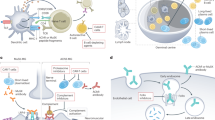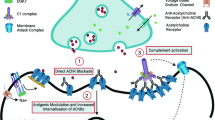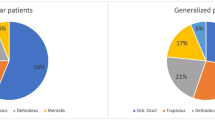Abstract
Autoantibodies to nicotinic acetylcholine receptors (AChRs) are demonstrable in sera of approximately 90% of patients with myasthenia gravis (MG), a disease of neuromuscular transmission1. The consistent abnormality in MG is a low amplitude of miniature endplate potentials (m.e.p.ps) due to decreased sensitivity of the postsynaptic membrane to the neurotransmitter, acetylcholine (ACh). This reflects a decrease in numbers of AChRs in the membrane (for review see ref. 2). The pathogenicity of anti- AChR antibodies has been documented in vivo by passive transfer of MG from human to mouse3 and from rat to rat4 and in vitro on cultured muscle cells5–8. However, titres of anti-AChR antibodies in serum do not correlate closely with severity of muscle weakness in MG patients1. This lack of correlation very probably reflects the heterogeneity of specificities of anti-AChR antibodies which is known to exist in MG2. For example, antibodies directed to determinants of AChRs which are inaccessible in vivo may be generated in the course of the disease without being relevant to disease pathogenesis. Identification of antigenic determinants of AChRs which are the primary target(s) of antibody attack in MG is a logical prerequisite to designing antigen-specific immunotherapy for this disease. We report here the production by hybridoma cells of monoclonal rat antibodies reactive with muscle AChR, both adult and fetal, in all of six mammalian species studied. Antibodies produced by two of these hybridoma lines bound to one or more antigenic determinant(s) exposed extracellularly, but remote from the binding site for cholinergic ligands, in the postsynaptic membrane of muscle, and caused a defect of neuromuscular transmission in mice, rats and guinea pigs. These findings establish conclusively that neuromuscular transmission can be impaired by monospecific anti–AChR antibodies which do not inhibit the binding of neurotransmitter to its receptor site.
This is a preview of subscription content, access via your institution
Access options
Subscribe to this journal
Receive 51 print issues and online access
$199.00 per year
only $3.90 per issue
Buy this article
- Purchase on SpringerLink
- Instant access to full article PDF
Prices may be subject to local taxes which are calculated during checkout
Similar content being viewed by others
References
Lindstrom, J., Seybold, M. E., Lennon, V. A., Whittingham, S. & Duane, D. D. Neurology 26, 1054–1059 (1976).
Lennon, V. A. in Clinical Immunology Update: Reviews for Physicians (ed. Franklin, E.) 259–289 (Elsevier, New York, 1979).
Toyka, K. V. et al. New Engl. J. Med. 296, 125–131 (1977).
Lindstrom, J., Engel, A. G., Seybold, M. E., Lennon, V. A. & Lambert, E. H. J. exp. Med. 144, 739–753 (1976).
Lennon, V. A. in Cholinergic Mechanisms and Psychopharmacology. Advances in Behavioral Biology (ed. Jenden, D. J.) 77–92 (Plenum, New York, 1977).
Bevan, S., Kullberg, R. W. & Heinemann, S. F. Nature 267, 263–265 (1977).
Anwyl, R., Appel, S. M. & Narahashi. T. Nature 267, 262–263 (1977).
Kao, I. & Drachman, D. B. Science 196, 527–529 (1977).
Lennon, V. A., Lindstrom, J. & Seybold, M. E. Ann. N. Y. Acad. Sci. 274, 283–299 (1976).
Galfre, G., Howe, S. C., Milstein, C., Butcher, G. W. & Howard, J. C. Nature 266, 550–552 (1976).
Hengartner, H., Luzzati, A. L. & Schreier, M. in Current Topics in Microbiology and Immunology (eds Melchers, F. Potter. M. & Warner, N. L.) 92–99 (Springer, New York, 1978).
Lambert, E. H., Lindstrom, J. M. & Lennon, V. A. Ann. N. Y. Acad. Sci. 274, 300–318 (1976).
Lindstrom, J. M. & Lambert, E. H. Neurology, Minneap. 28, 130–138 (1978).
Lennon, V. A., Palmer, A. C., Pflugfelder, C. & Indrieri, R. in Genetic Control of Autoimmune Disease (eds Rose, N. R., Bigazzi, P. E. & Warner, N. L.) 295–306 (Elsevier, New York, 1978).
Lindstrom, J. M., Einarson, B., Lennon, V. A. & Seybold, M. E. J. exp. Med. 144, 726–738 (1976).
Christadoss, P., Lennon, V. A., Lambert, E. H. & David, C. in ICN-UCLA Symp. Molec. Cell. Biol. Vol. 16 (eds Bach, F., Bonavida, B. & Vitetta, E.) 249–256 (Academic, New York, 1979).
O'Farrell, P. H. J. biol. Chem. 250, 4007–4021 (1975).
Jensenius, J. C. & Williams, A. F. Eur. J. Immun. 4, 91–97 (1974).
Gomez, C. M. et al. Biophys. biochem. Res. Commun. 88, 575–582 (1979).
Moshly-Rosen, D., Fuchs, S. & Eshhar, Z. FEBS Lett. 106, 389 (1979).
Lerner, R. A., Glassock, R. J. & Dixon, F. J. J. exp. Med. 126, 989–1004 (1967).
Almon, R. R. & Appel, S. H. Biochim. biophys. Acta 393, 66 (1975).
Weinberg, C. P. & Hall, Z. W. Proc. natn. Acad. Sci. U.S.A. 76, 504 (1979).
Chang, H. W. & Bock, E. Biochemistry 16, 4513–4520 (1977).
Eilat, D., Asofsky, R. & Laskov, R. J. Immun. 124, 766–768 (1980).
Andrzejewski, C., Stollar, B. D., Lalor, T. M. & Schwarz, R. S. J. Immun. 124, 1499–1502 (1980).
Author information
Authors and Affiliations
Rights and permissions
About this article
Cite this article
Lennon, V., Lambert, E. Myasthenia gravis induced by monoclonal antibodies to acetylcholine receptors. Nature 285, 238–240 (1980). https://doi.org/10.1038/285238a0
Received:
Accepted:
Issue date:
DOI: https://doi.org/10.1038/285238a0
This article is cited by
-
Role of complement and potential of complement inhibitors in myasthenia gravis and neuromyelitis optica spectrum disorders: a brief review
Journal of Neurology (2021)
-
Neural Autoantibody Profile of Primary Achalasia
Digestive Diseases and Sciences (2010)
-
Myasthenia gravis as a prototype autoimmune receptor disease
Immunologic Research (1997)



